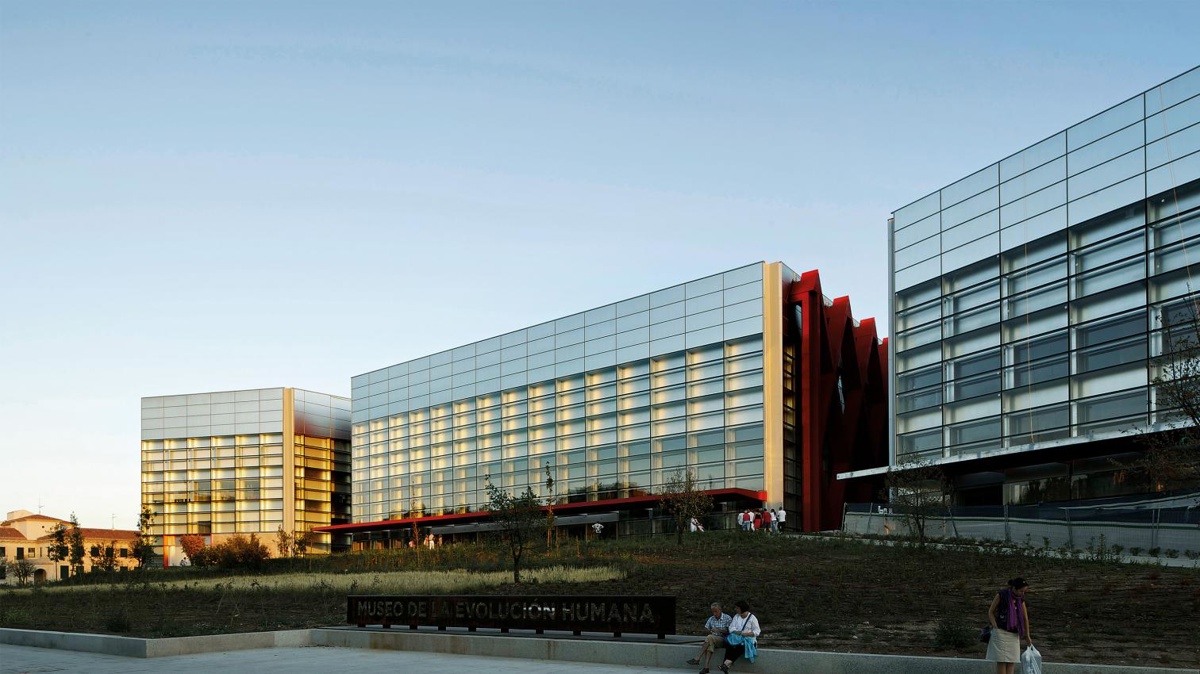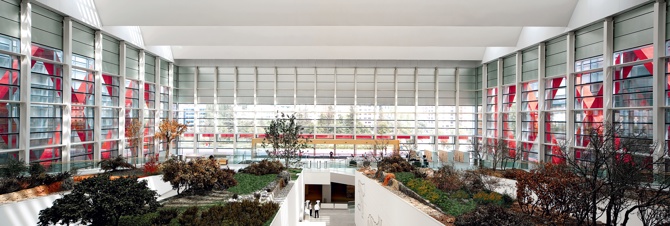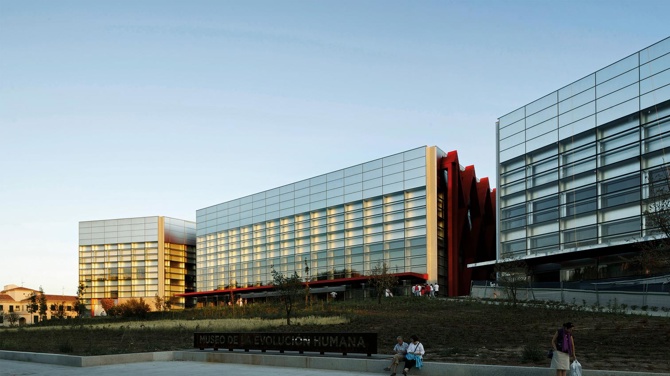Loading...
Located on the banks of the Arlanzon River as it flows through Burgos, the new complex has a material and fluvial relationship with the Atapuerca site. The palaeontological and archaeological findings the Sierra de Atapuerca is of such importance that it was considered necessary to create a space in which to promote their study and explanation and to exhibit them to the generalThe paleontological and archaeological findings of Atapuerca were so considerable that it was necessary to build a space to promote their study as well as to display them and make them known to the wider public.
The new complex gathers three buildings: the Museum of Human Evolution, the National Research Center on Human Evolution and the Exhibitions and Congress Center. These last two are separated from the museum, which occupies a central position, through two cracks that let natural light go through and that connect the riverside area with the rear urban area, recalling, just like inside the museum, the spatial sensations that the railway trench of the Atapuerca mountains arouses.
Furthermore, while the museum is characterized from the exterior by the red lozenge screen of its side facade, the National Research Center, located to the east, is clad on two sides by green panels of cut out rhombi, and the Exhibitions and Congress Center, to the west, covers part of its facade with a double skin formed by red profiles and sheet, and cut-out white sheet outlining an abstract drawing.
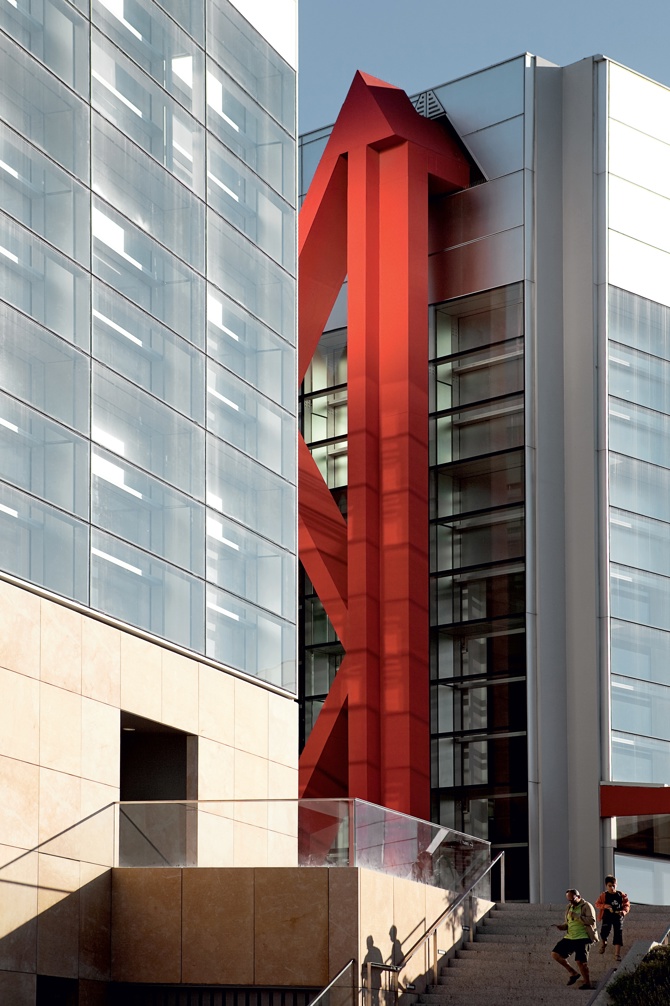
The complex fills an artificial slope that descends towards the river course, and to achieve this it was necessary to raise the access to the buildings five meters, thus managing to separate visitors from road traffic and offer them unobstructed views of the cathedral of Burgos. Extending the slope, and already inside the museum, the project includes an abstract recreation of the Atapuerca landscape, through sections or fragments of the ground surface, protected by a clear roof of aluminum and glass with a series of folds and that resembles the interior of a large greenhouse.

The ‘ravines’ that are tucked between the prisms display the geological and paleontological aspects of the site, reproducing the spatial experience of the excavation cuts and the strata of the territory. Behind the large prisms three levels joined by ramps display objects and installations in a more conventional manner.
The structure of the building is of concrete and a mix of steel and concrete, and and boldly asserts its presence in the exterior of the museum. The exterior cladding combines transparent and opaque glazed surfaces made of silver glass by means of a double skin system and steel panels in different colours and stone of an amber hue.
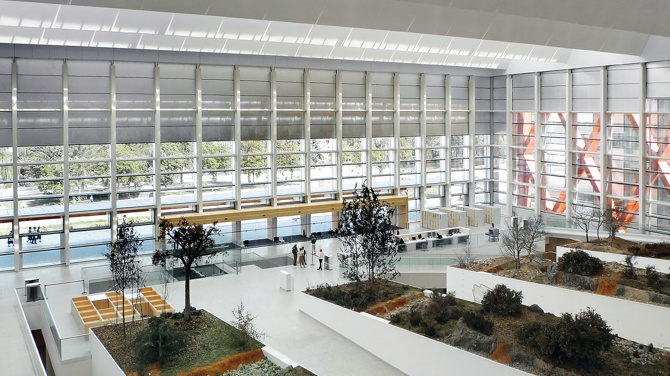
General information
Human Evolution Complex of Burgos
YEAR
Status
Built
Option to visit
Address
Wwy. Sierra de Atapuerca, s/n
09002 Burgos - Burgos
Latitude: 42.339527044
Longitude: -3.697095419
Classification
Construction system
The structure of the building is made of concrete and a mix of steel and concrete. The external enclosure is formed by a double skin system in silver and transparent glass combined with a plinth with sheet metal and stone panels.
Built area
Involved architects
Involved architectural firms
Information provided by
Ministry of Transport, Mobility and Urban Agenda (MITMA)
-
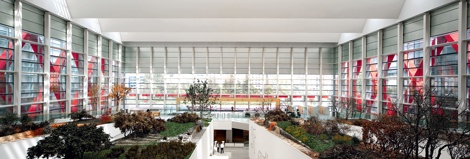
Jordi Sarrá (2017). Juan Navarro Baldeweg. Ministry of Transport, Mobility and Urban Agenda (MITMA) -

Navarro Baldeweg Asociados (2017). Juan Navarro Baldeweg. Ministry of Transport, Mobility and Urban Agenda (MITMA)
Location
Itineraries
https://serviciosdevcarq.gnoss.com/https://serviciosdevcarq.gnoss.com//imagenes/Documentos/imgsem/7e/7ead/7ead7960-c700-4ff9-9062-9b2fbe8513f1/ee2be215-ced6-4f63-a6c7-e5f12edf0846.jpeg, 0000007864/1.jpeg
https://serviciosdevcarq.gnoss.com/https://serviciosdevcarq.gnoss.com//imagenes/Documentos/imgsem/7e/7ead/7ead7960-c700-4ff9-9062-9b2fbe8513f1/1618d437-5e8b-4067-979d-178248e45c4f.jpeg, 0000007864/2.jpeg
https://serviciosdevcarq.gnoss.com/https://serviciosdevcarq.gnoss.com//imagenes/Documentos/imgsem/7e/7ead/7ead7960-c700-4ff9-9062-9b2fbe8513f1/6acfc920-b203-4ba0-925b-af4cf80b479c.jpg, 0000007864/Panoramica Interior.jpg
https://serviciosdevcarq.gnoss.com/https://serviciosdevcarq.gnoss.com//imagenes/Documentos/imgsem/7e/7ead/7ead7960-c700-4ff9-9062-9b2fbe8513f1/75e0c8a6-3097-453c-adf9-227fc4795b7c.jpg, 0000007864/Vista Exterior.jpg
https://serviciosdevcarq.gnoss.com//imagenes/Documentos/imgsem/7e/7ead/7ead7960-c700-4ff9-9062-9b2fbe8513f1/980216c3-67da-419d-8c1d-61f96507529c.jpg, 0000007864/Alzado desplegado 1.jpg
https://serviciosdevcarq.gnoss.com//imagenes/Documentos/imgsem/7e/7ead/7ead7960-c700-4ff9-9062-9b2fbe8513f1/2d121a8b-6f14-4513-bc09-7287d6cee925.jpg, 0000007864/Alzado desplegado 2.jpg
https://serviciosdevcarq.gnoss.com//imagenes/Documentos/imgsem/7e/7ead/7ead7960-c700-4ff9-9062-9b2fbe8513f1/3d95e647-7b95-4e4c-994a-192c397c16bf.jpg, 0000007864/Alzado desplegado 3.jpg
https://serviciosdevcarq.gnoss.com//imagenes/Documentos/imgsem/7e/7ead/7ead7960-c700-4ff9-9062-9b2fbe8513f1/8a845e8e-effd-4146-b3d9-9d9be7ee2c13.jpg, 0000007864/Planta del conjunto.jpg
https://serviciosdevcarq.gnoss.com//imagenes/Documentos/imgsem/7e/7ead/7ead7960-c700-4ff9-9062-9b2fbe8513f1/eca319a1-a6d7-4965-a6d6-f5060546d43e.jpg, 0000007864/Seccion Longitudinal.jpg
